
|
|
|
|
|
|
|
|
|
|
Well, it was fun while it lasted, but it's finally over: this is the last Web Wandering column to be published in PC Report. I want to begin by thanking all of the people who sent in supportive e-mail during the column's protracted death scene. In fact, the applause of My Public has made me so giddy that I have decided to continue the column for a while.
How? You may well ask: after all, I am barred from my BCS pulpit and thoroughly defrocked. How frocked I was to begin with is an open question, but that's a story for another day.
The man who dies by the Web may as well live by it! For at least the next few months, as long as there is reader interest, Web Wandering will live on out there in TCP/IP-land. Some of the topics I am tentatively planning to cover include:
For the moment, Web Wandering will find its home at www.miken.com. I will also continue to host the existing on-line issues of PC Report at that page for a while, at least until I need the disk space.
I hope to produce about one Web Wandering column per month. If you are interested in joining the Web Wandering virtual family, please send me some e-mail at ww@miken.com. To help me serve you better, I would appreciate it if you could answer at least a few of the following questions:
I sincerely hope you have enjoyed Web Wandering and found it useful. Useful enough, in fact, to follow it out into the uncharted virtual jungle. Thanks again for all the encouraging e-mail; as I forsake the printed page, I'll try not to let you down.
By the same token, you can now send me Web Wandering-related mail to ww@miken.com.
Internet mail may be the only mostly-free lunch left here in the late twentieth century. With most Internet providers, you pay a flat fee for a given number of hours on-line, even if you spend that entire time sending and receiving e-mail. No matter how many messages you send, no matter how many recipients each message is addressed to, no matter how large each message is, and no matter how far each message must travel, there is never any extra charge.
It's an impressive bargain. Once you have paid your Internet provider and your phone bill, you have an essentially unlimited way to communicate with people anywhere in the world. Compared to the costly e-mail offered by on-line services, Internet mail is practically free. In addition to basic mail fees, on-line services also tend to limit the maximum size of each message and to charge a small fee for every recipient.
Given the rich formatting we Windows users have grown accustomed to, Internet mail is a real comedown. You will find yourself doing things like using ALL CAPS for emphasis, _underscores_ instead of italics, *asterisks* instead of boldface, and so on. Even the lowly tab key is verboten. The truly desperate may resort to angle codes (like <g> for "grin"), or, in the most depraved cases, "emoticons" (e.g., :->).
Since Net mail can only carry printable ASCII, it's obviously impossible to directly transmit binary files. Any file or document that includes non-printable characters must be transformed using an encoding program before it can be sent, and the recipient must have a decoding tool that can reverse the original encoding process.
Unfortunately, "binary files" encompasses almost everything except simple text memos. For example, I am writing this column using Word for Windows. Word document files contain lots of binary information, so if I wanted to send the column to someone via Net mail, I would have to convert it to text and lose all the formatting, or encode the document file and hope the recipient can decode it to recover the original Word document.
This problem is compounded by the fact that an Internet e-mail message doesn't always travel directly from the sending system to the receiving system. A message can be "handed off" from one mail host to another many times during its journey.
Even worse, e-mail messages sit in ordinary UNIX text files on both the sending and receiving systems until they are processed. Anyone with the necessary privileges can read these files, and lots of people at both ends have this access.
The bottom line is that Internet mail is not very secure. Don't write anything in a mail message that you wouldn't write on a postcard; the security level is about the same. Your letter carrier can read your postcards if he's bored enough, and your sysop may be equally tempted.
It's especially important to protect certain types of information. For example, an ill-disposed person could easily write a program to scan a Net mail stream for credit card numbers. The same goes for Social Security numbers and so on.
To date, I haven't read many reports of crimes related to e-mail theft, but as the Internet continues to expand, it's certain that inventive criminals will start to take advantage of the unwary. You don't want to be the first mail-theft victim to make the front page of the Times.
Just as with binary file transmission, there are ways to "work around" the Net's security weaknesses. All the solutions I have seen so far involve encryption, but at the moment, these solutions are all too hard to use for anyone except the most paranoid.
The last major Net mail weakness is a sort of descendant of the security issue. The Internet mail system uses a standard called Simple Mail Transfer Protocol (SMTP) to process e-mail messages. Unfortunately, simple is exactly what this protocol is: there's absolutely no provision for authenticating the sender of a message.
At the moment, you can send a message pretending to be absolutely anybody with total impunity. If you are feeling Presidential, set yourself up as hillary@whitehouse.gov and SMTP will blithely forward your obscene message to Al D'Amato. Or, if you want the frisson of real power, impersonate billg@microsoft.com.
Encryption schemes often provide an authentication mechanism, but they continue to be much too inconvenient for day-to-day use. It's best to use a measure of common sense and be a little suspicious if you get what seems to be a mash note from Sandra Bullock.
If you use a UNIX shell account to access the Internet, your provider will have a number of mail clients. The simplest, available in some form on all UNIX systems, is the mail program. Pine is a friendly, menu-driven mail client offered by many providers, and there are several others available as well.
Most readers of this column probably get their Internet service via a PPP or SLIP account. To use Internet mail with this type of connection, you will need a mail client that can handle two standards, POP (Post Office Protocol) and SMTP (Simple Mail Transfer Protocol). POP is used to retrieve incoming mail and SMTP to send outgoing mail.
You will also need to know your provider's mail server addresses. Many times, a provider's mail servers will use the same domain name as the provider does. TIAC's SMTP and POP servers, for example, can be reached using the address "tiac.net." Other providers may use a separate domain name for mail services.
The mail functionality built into browsers tends to be very simple. Navigator can send and receive e-mail, but the program's designers clearly didn't set out to provide full Net mail services. In fact, Navigator's e-mail window seems mostly intended to handle "mail to" links on Web pages.
After trying a variety of commercial, shareware, and freeware mail clients, I have settled on Qualcomm's (www.qualcomm.com) Eudora Pro as my mail client. Once you get past the setup, Eudora Pro is powerful, flexible program that's easy to use even for beginners. For more advanced users, the package offers sophisticated convenience features like automatic mail filtering.
Eudora Pro offers a wide variety of useful Internet mail functions, including:
The Eudora Pro Options dialog box is broken down into a number of "categories," which are analogous to the "pages" in a Win95 tabbed dialog box. At a minimum, you need to set the following items:
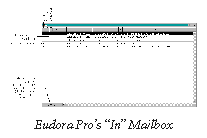 Once you have finished choosing your Eudora Pro options,
you can go on-line for the first time to see if you have any mail.
Start your Internet connection, then choose the "File / Check
Mail" command or press <Ctrl> + <M>.
Once you have finished choosing your Eudora Pro options,
you can go on-line for the first time to see if you have any mail.
Start your Internet connection, then choose the "File / Check
Mail" command or press <Ctrl> + <M>.The first time you try to connect, Eudora Pro will prompt you for the password for your mail account. This is the same password you use to log into your Internet provider. Once you have entered the correct password, Eudora will download any incoming messages and place them in the "In" mailbox.
Assuming you plan to answer your mail off-line, you can disconnect from your Internet provider once Eudora Pro has downloaded your incoming mail. New incoming messages will be marked with a bullet in the S (for Status) column.
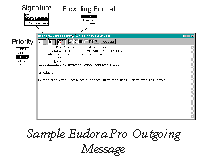 When you create a new message (either with the "Message
/ New Message" command or by pressing <Ctrl> + <N>), Eudora
Pro will display a simple message template. In the simplest case,
to send a message, you can just fill in the "To" and "Subject"
lines, type something in the message area, and click the "Queue"
button (assuming you have turned off the "Send Immediately"
option). The next time you log on to your provider and check for messages,
Eudora Pro will dispatch the new message.
When you create a new message (either with the "Message
/ New Message" command or by pressing <Ctrl> + <N>), Eudora
Pro will display a simple message template. In the simplest case,
to send a message, you can just fill in the "To" and "Subject"
lines, type something in the message area, and click the "Queue"
button (assuming you have turned off the "Send Immediately"
option). The next time you log on to your provider and check for messages,
Eudora Pro will dispatch the new message.Some other things to consider when sending messages:
It's important to be careful when creating and using nicknames. Unfortunately, Eudora Pro's nickname expansion function has a fatal flaw: if you mistype a nickname, the program will assume it is an e-mail address. For example, suppose that you defined the nickname "mike" for me and went to send me a message. On the "to" line, you carelessly typed "mikke" instead of "mike."
Eudora Pro would blithely accept and transmit the message. Rather than sending the message to me, you would end up sending mail to whoever has the user ID "mikke" on your Internet provider's system. If there's nobody with that user ID on the system, you would get a "bounce" message. If there is a "mikke" on your provider's system, that user would receive the message, and you would never know that anything went wrong, unless "mikke" sends you an angry and/or confused reply.
The lesson here is twofold: any e-mail ID that doesn't have a domain qualifier (something after an @ sign) is assumed to go to your host system; and, if you send a message that could embarrass you or get you into trouble, be very careful typing the nicknames!
Eudora Pro can actually help you with this problem. If you use the "Tools / Nicknames" command to open the nickname list, you will see buttons labeled "To:," "CC:," and so forth. If you highlight a nickname and click one of these buttons, Eudora Pro will add the nickname in question to the selected recipient field. This is the safest way to add nicknames to an outgoing message.
As I stated above, a nickname can actually refer to a list of e-mail IDs. You can place as many e-mail IDs (separated by commas and/or carriage returns) as you want in the "Address(es)" box of a nickname. Some Internet providers limit the total length of recipient lists, so you may want to test a nickname that expands to a really long list of names. These limits shouldn't interfere with typical lists of e-mail IDs.
Used carefully, filters can save a lot of work. For example, there's a company called Telemail that specializes in sending out junk e-mail, such as advertisements for low-cost long distance services. I have a filter that dumps all messages from Telemail directly into the Trash. This way, Telemail still has to pay to keep my e-mail ID in their database and to send out the junk e-mail, but I never see it. Sounds like the best of both worlds, eh?
One useful filter that I recommend is: test the "To:" field against "(Recipient list suppressed)" and dump any matching messages in the Trash. When a message's list of recipients gets too long, Net mail servers will generally decide not to copy it to every recipient. Instead, the server places the message "(Recipient list suppressed)" in the "To:" field to save bandwidth and mailbox space. The message still goes to all the recipients, but the complete list of recipients is not duplicated.
Most servers will require dozens or hundreds of recipients before they activate this suppression feature, so it's pretty safe to dump messages that have the "(Recipient list suppressed)" scarlet letter. If a message has that many recipients, it probably wasn't aimed very specifically at you, and in fact, it's probably junk mail.
You can also use filters to do things like transfer routine messages and recurring newsletters to a specific mailbox so you can look at them when you have time. If you subscribe to a mailing list, you can automatically collect messages from the list in their own mailbox. The possibilities are nearly endless.
Version 2.2 includes a number of new features and bug fixes, but it is especially of interest to Windows 95 users: the 2.2 update package includes a full 32-bit Win95-compliant version of Eudora Pro. If you are using Win95 or Windows NT, I strongly recommend the upgrade, especially as it's offered free of charge.
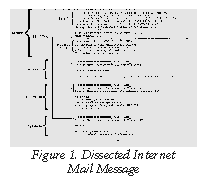 Even if you use a sophisticated mail client like Eudora
Pro, there will be times when your Internet mail will go awry. Sometimes,
you'll get a message that doesn't seem to make any sense. Other times,
you'll get a message and won't be able to figure out who sent it or
where it came from. That's part of the rustic charm of the Net; there's
no such thing as a sure bet in the wired world.
Even if you use a sophisticated mail client like Eudora
Pro, there will be times when your Internet mail will go awry. Sometimes,
you'll get a message that doesn't seem to make any sense. Other times,
you'll get a message and won't be able to figure out who sent it or
where it came from. That's part of the rustic charm of the Net; there's
no such thing as a sure bet in the wired world.This section of Web Wandering is designed to teach you how to pick apart an Internet mail message, should you ever need to. Armed with a little understanding of how the system works, you will be prepared when it doesn't work.
To understand message dissecting, follow along on Figure 1, which is a simple test message that I sent to myself from my account on TIAC to my account on The World.
The body, which contains the message text you typed and any attachments, is the portion of the message that the mail system doesn't examine. The body is simply copied from host to host until the message reaches the recipient. It's a nice dichotomy: the machines care about the headers and ignore the body; we care about the body and ignore the headers.
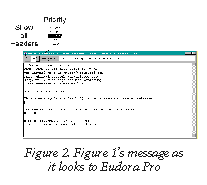 Understanding the headers can come in very handy if something
goes wrong in transit, or if you are having trouble figuring out where
a message came from. The latter actually happens more often than you
might think.
Understanding the headers can come in very handy if something
goes wrong in transit, or if you are having trouble figuring out where
a message came from. The latter actually happens more often than you
might think.Figure 2 shows how Eudora Pro displays my test message by default. You'll notice that none of the gobbledygook found at the top of Figure 1 is visible. That's because Eudora Pro hides the "non-useful" headers unless you ask to see them by clicking the "Blah Blah Blah" button in the upper left corner of the message window. This activates "Show All Headers" mode.
Once the headers are visible, you'll notice that every Internet mail message starts with a line "From xxx@yyy.zzz date-and-time-stamp." This is called the "Top of Message" line and, though it may not look that way, it is in an excruciatingly exact and specific format.
On the UNIX hosts that for many years owned the Net, mail messages were stored lumped together in ordinary text files with no special delimiters. To tell where one message ended and another began, the UNIX hosts would match each line against a special pattern designed to detect the Top of Message line. Eudora Pro still uses this same method. To see for yourself, open one of the mailbox (*.MBX) files in the Eudora directory with a text editor: you'll see a bunch of messages delimited by Top of Message lines.
Right after the Top of Message line are one or more lines that begin with the word "Received" followed by a colon. These are the handoffs.
Each handoff represents a stage in the message's journey, a transition from one host to another. The handoffs are in "backwards" order, with the last first: when a host forwards a message, it copies the Top of Message line, sends its handoff, then copies the rest of the message. In the Figure 1 sample message, the test message was handed off from me (miken.tiac.net) to cola.tiac.net, one of TIAC's mail servers. The mail server, in turn, handed the message off to the destination machine, world.std.com.
By comparing the timestamps on the handoffs, you can see that the message took about three minutes to make its trip from my computer to my mailbox on the World. You can also see that this particular message took a very straightforward route from sender to recipient. That isn't always the case: some messages may go through a dozen or more handoffs before arriving at their destination. This is one of the reason that Eudora Pro "hides" the handoffs by default; they can take up a lot of screen real estate.
After the handoffs, you'll usually find the message ID. This is a large and usually completely meaningless number. Every message is required to have a unique ID, which will be generated for you.
The last headers are among the most important to humans: the Date, From, To, and Subject lines. I have called these "required" headers though it's technically possible to send mail with none of these lines supplied. These headers make it possible to have a civilized mail conversation, so they should never be neglected. I especially encourage you to type a descriptive Subject line so that both you and your correspondents will be able to figure out what's going on.
In the sample message, you will see a number of headers that begin with "X-." These are called "user defined" headers because they are guaranteed to be ignored by the Internet mail system. In most cases, "X-" headers are simply informational, or they may provide useful clues to the recipient's mail client in cases where both the sender and the recipient are using the same mail client.
When a binary file is encoded for transmission over the Net, it becomes a mass of incomprehensible letters and symbols. The mail client will convert this gibberish back into the original binary file and substitute a placeholder in the message you see. In Figure 2, for example, you can see that the attachment in the test message was converted and saved as G:\WIN95\EUDORA\ATTACH\AUTOEXEC.BAT.
Each of the encoding formats used on the Web (the most popular are MIME, UU, XX, and BinHex) has its own way of delimiting the attachments and triggering decoding. A good mail client will be able to detect and transparently decode out a variety of attachment formats.
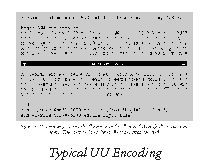 Once people began to attach binary files to Internet mail
messages, there began to be demand for an organized way of breaking
a mail message up in to parts, some of which were text and some of
which were binary. The result was a standard called MIME (Multi-part
Internet Mail Extensions).
Once people began to attach binary files to Internet mail
messages, there began to be demand for an organized way of breaking
a mail message up in to parts, some of which were text and some of
which were binary. The result was a standard called MIME (Multi-part
Internet Mail Extensions).MIME actually goes much farther than merely specifying a way to transmit mixed data types over the ASCII-only Internet mail system. The standard provides a flexible and extensible method for identifying not only the different parts of a message but also the types of data that make up each part and what the recipient's mail client should do with each part.
You can get an idea of MIME's structure by examining Figure 1. You can see that Eudora Pro's MIME encoder broke my test message up into three parts, the text message, the enclosure, and the signature. You can also see that each part is delimited by a specific string and that each part has detailed information about the type of the data it contains.
Eudora Pro provides excellent MIME support. When you specify an attachment, Eudora will decide whether the attachment can be sent "as is" or if it must be encoded first. It performs any necessary encoding and adds all the proper MIME headers. The process is reversed when a MIME-encoded message is received.
Unfortunately, support for MIME is not universal. Many UNIX mail programs have no MIME support whatever; to extract data from a MIME-encoded message, people thus afflicted have to run the message through a standalone MIME decoder. The mail systems of on-line services like CompuServe also tend to be really bad at understanding MIME.
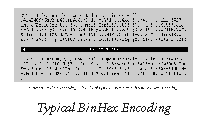 As I stated above, there are three popular encoding formats
in addition to MIME: UU, XX, and BinHex. XX encoding is rarely used
now, so I am ignoring it. UU encoding is still widely used, but it
is less versatile and much less efficient than MIME encoding. If you
have to send a binary file to someone whose mail-decoding capabilities
are in doubt, chose UU encoding; it's the least common denominator.
As I stated above, there are three popular encoding formats
in addition to MIME: UU, XX, and BinHex. XX encoding is rarely used
now, so I am ignoring it. UU encoding is still widely used, but it
is less versatile and much less efficient than MIME encoding. If you
have to send a binary file to someone whose mail-decoding capabilities
are in doubt, chose UU encoding; it's the least common denominator.BinHex encoding is largely confined to the Mac world, and its popularity is fading, but it's still possible that you may receive a message encoded with it.
To help you recognize the other decoding schemes, I have included short sample listings in each format. If you ever receive a message with these types of encoding, and your mail client won't decode them, you'll need to run the relevant messages through a standalone decoder like one of those listed in Table 1.
| What | Where | Description |
|---|---|---|
| ESS-Code | Shareware* | Good shareware encoder/decoder. 32-bit version available. Supports UUE, BtoA, SHIP, MIME. Better with mail enclosures than news. |
| Wincode | Shareware* | Freeware encoder/decoder. Decent, but only a 16-bit application. Has some annoying interface quirks. No MIME support. |
| UUDeview | www.uni-frankfurt.de/~fp/uudeview | Extremely powerful DOS-based decoder. Will process files that choke most other decoders. Excellent for news (segmented files). Crude Windows port available, but stick with DOS. Only major flaw: no BinHex. |
* "Shareware" means that the program in question has no home page of its own. These utilities are readily available from shareware.com, Tucows, Consummate Winsock Apps, on CompuServe, etc.
When you subscribe to a mailing list, you will receive copies of all the messages posted to the mailing list. If you reply to such a message, your reply will be replicated to everyone else that has subscribed. If you send a message to the list, every subscriber receives it.
Mailing lists act as discussion groups and they tend to relate to very specific topics. For example, many types of automobiles have their own mailing lists, and not just the "classic" collector models like Ferraris and Corvettes. There are lists for all types of autos, including joke cars like the Morris Minor. Owners and enthusiasts join to swap tips, buy and sell cars, hunt for parts, commiserate over breakdowns and electrical fires (British cars only), etc., etc.
As in the newsgroups, the focus of a mailing list is likely to be quite narrow. You are probably either really interested in the list's topic or you couldn't care less.
Like the newsgroups, there are lists on all sorts of different topics, from collecting to desktop publishing to zithers. Mailing lists can be great sources of specific information that can be very hard to locate otherwise. Many vendors maintain mailing lists to help customers stay abreast of the latest product upgrades and fixes.
The only downside to joining a mailing list is the volume of incoming mail you will receive. Some lists receive dozens of posts a day, and all of those posts will be copied into your mailbox. Certain lists offer a "digest" version which collects an entire day's posts and sends them in a chunk, but even this can be hard to keep up with.
One way to keep your mailing list load manageable is to use Eudora Pro's filters. For example, if you're looking to buy a Citroën 2CV, you could subscribe to the "Deux Chevaux" mailing list and send all messages that don't contain the words "For Sale" in the Subject line to the Trash. This would boil the list down to what you're interested in.
The most important rule to remember when dealing with a mailing list is that every list has two addresses, one for administrative business (like subscribing) and one for posting to the list. Ignoring this distinction will mark you as a newbie and may get you flamed: most lists are plagued by hapless people begging to be "unsubscribed."
There are a number of "mailing list lists" out on the Web. I have supplied some of their URLs in Table 2. Some of the more advanced list pages allow you to subscribe to a list right on the spot just by filling out an on-line form. Unfortunately, there is no one really comprehensive collection of lists; if you are looking for a specific list, you'll probably have to check several of the list collection sites to find it.
| List | URL | Description |
|---|---|---|
| Macintosh Mailing Lists | rever.nmsu.edu/~elharo/faq/mailinglists.html | Though theoretically for Macintosh users, there are many lists here for anyone interested in digital imaging or desktop publishing. |
| Publicly Accessible Mailing Lists | www.NeoSoft.com/internet/paml | Good resource for browsing. Not as complete or frequently updated as catalog.com, but most of the longest-running lists are here. Best of all, lists are viewable by subject. |
| Mailing List Catalog | catalog.com/vivian/interest-group-search.html | Exhaustive, detailed searchable catalog of mailing lists. Probably the definitive resource if you know what you're looking for. |
| Yahoo | Search: "mailing list" | Some of the most popular mailing lists are catalogued in Yahoo. Narrowly-targeted lists aren't likely to be here. |
To subscribe to a list, you generally send an e-mail message to its listserv that contains the word "subscribe," the name of the list, and your name. If the procedure worked, the listserv will return a robot message telling you that you have subscribed and perhaps giving you information about the list and its policies.
To cancel your subscription, you would send another e-mail message to the listserv, this time containing the word "unsubscribe" and the list name. Again, you will normally receive a confirmation message once your request has been processed.
To join this list, I would send an e-mail message to majordomo@triumph.cs.utah.edu containing the text:
subscribe british-cars Michael Newcomb
This would add me to the list. As a precaution, I might duplicate the above text into the Subject line, since a few list servers read that rather than the message body.
If I wanted to post a message to the list, so everyone would get it, I would send my message as an e-mail to british-cars@triumph.cs.utah.edu. Again, notice that administrative messages go to "majordomo," but messages for the mailing list go to "british-cars."
If I tired of the list and wanted to cancel my subscription, I would send an e-mail message to majordomo@triumph.cs.utah.edu containing the text:
unsubscribe british-cars
That should do it. You may have noticed that the list is also available as a "digest," that is, a collection of a day's worth of messages at a time. To receive the digest, you would subscribe to "british-cars-digest" instead of "british-cars."
![]()